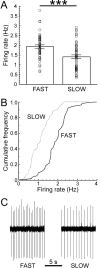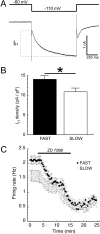Mice selectively bred for high- or low-alcohol-induced locomotion exhibit differences in dopamine neuron function
- PMID: 19122113
- PMCID: PMC2670605
- DOI: 10.1124/jpet.108.146316
Mice selectively bred for high- or low-alcohol-induced locomotion exhibit differences in dopamine neuron function
Abstract
Elevated sensitivity to the euphoric or stimulant effects of ethanol is associated with higher levels of alcohol use in some human populations. Midbrain dopamine neurons are thought to be important mediators of both ethanol reward and locomotor stimulation. Patch-clamp recordings were used to examine the electrical properties of dopamine neurons in a genetic model of heightened (FAST) and reduced (SLOW) sensitivity to the locomotor-activating effects of ethanol. Pacemaker firing of dopamine neurons was faster in FAST than SLOW mice, as was the current density through I(H) channels. Acute administration of ethanol accelerated the firing of dopamine neurons to a greater extent in recordings from FAST than SLOW mice. Dopamine neurons from FAST mice also exhibited reduced GABA(A) receptor-mediated synaptic input, compared with SLOW mice. The results suggest that dopamine neuron I(H) channels, firing rate, and GABAergic input may play a role in sensitivity to the locomotor activation observed at early time points after ethanol administration and could underlie differences in sensitivity to alcohol relevant to risk for alcohol abuse.
Figures







References
-
- Addicott MA, Marsh-Richard DM, Mathias CW, and Dougherty DM (2007) The biphasic effects of alcohol: comparisons of subjective and objective measures of stimulation, sedation, and physical activity. Alcohol Clin Exp Res 31 1883-1890. - PubMed
-
- Bechtholt AJ and Cunningham CL (2005) Ethanol-induced conditioned place preference is expressed through a ventral tegmental area-dependent mechanism. Behav Neurosci 119 213-223. - PubMed
-
- Beckstead MJ, Grandy DK, Wickman K, and Williams JT (2004) Vesicular dopamine release elicits an inhibitory postsynaptic current in midbrain dopamine neurons. Neuron 42 939-946. - PubMed
-
- Boehm SL 2nd, Piercy MM, Bergstrom HC, and Phillips TJ (2002) Ventral tegmental area region governs GABA(B) receptor modulation of ethanol-stimulated activity in mice. Neuroscience 115 185-200. - PubMed
Publication types
MeSH terms
Substances
Grants and funding
LinkOut - more resources
Full Text Sources

